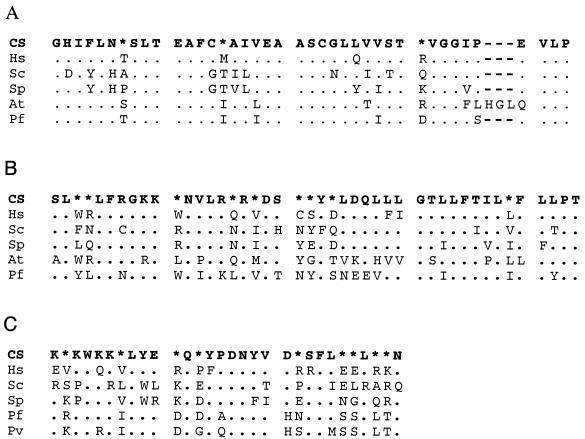FIG. 3.
Best-conserved sequence blocks of PIG-A (A), GPI1 (B), and PIG-C (C). The top lines represent the consensus sequence (CS), which was defined when a residue occurred in at least 51% of the aligned sequences; otherwise, positions are indicated with asterisks. The species are H. sapiens (Hs), S. cerevisiae (Sc), S. pombe (Sp), A. thaliana (At), and P. falciparum (Pf). Dots in the alignments indicate the same amino acid as shown in the consensus; gaps are shown by dashes. The figure was prepared using ASAD (Keith Satterley, ftp://ftp.wehi.edu.au/pub/biology). (A) The best-conserved region in PIG-A. Of the 43 positions, 23 are invariant in the five species. Note that the sequence in P. falciparum adheres to the consensus to a similar degree as the other sequences. The protein from Arabidopsis has an insertion of three amino acids. Accession numbers are NP_002632 (Hs), NP_015150 (Sc), CAB09127 (Sp), and AAK62657 (At). (B) A conserved region of GPI1. These genes evolved faster, but a consensus can be defined for most positions in the conserved blocks. The sequence from P. falciparum again fits the consensus as expected. Some of the variable positions have retained the same character, for example, hydrophobicity. Accession numbers are AAC32661 (Hs), CAB10806 (Sp), AAB17870 (Sc), and NP_191276 (At). (C) A putative fragment of PIG-C in Plasmodium aligned with human and yeast PIG-C sequences. PIG-C is a short and not very strongly conserved protein. We have tentatively identified fragments of the possible homologs in P. falciparum and P. vivax (Pv), essentially based on the alignment shown. The two plasmodial sequences are almost identical over the 30 amino acids. Sources are the GSS sequence AZ573855 (Pv), the truncated cDNA AU087281 (Pf), and the protein submissions Q92535 (Hs) and AAB68262 (Sc).

